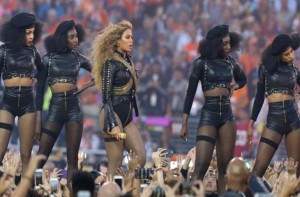
After a hiatus, the blog is back. And I, like everyone else, want to talk about Beyoncé’s new song and video, “Formation.” But before I do, I’d ask readers to first read/listen to the following:
- Yaba Blay’s article about the use of “Creole” as distinct from “Negro” in Beyoncé’s lyrics.
- Shantrelle Lewis’ article about Beyoncé’s incorporation of New Orleans imagery, especially images related to Hurricane Katrina.
- Dave Zirin’s conversation with Brittney Cooper (aka Professor Crunk) about the video, Beyoncé’s politics, and the Super Bowl halftime show performance.
These writers and scholars have already addressed many of the most salient issues surrounding the video and the immediate cultural response to it.
I would like to discuss two ideas I have yet to see unpacked and which directly relate to my own scholarship. First, I want to think about the ways the “Formation” video can act as a 21st century example of ritual performance, the kind which Black artists such as Ed Bullins, Amriri Baraka, and Barbara Ann Teer emphasized in the 1970s, and which acted as a kind of extension of the Black Power Movement. Second, in Part Two of this blog post, I will delve into the cultural aesthetic of the “Formation” performance at the 2016 Super Bowl halftime show, which derived some of its aesthetic inspiration from the Black Panthers. So, what’s all this fuss about “Formation,” anyway?
In my 2015 article, “Pageants of Propaganda: the Ritual Theatre of Ed Bullins”*, I argue that Bullins’ work with the New Lafayette Theatre in the 1970s illustrated the application of ritual performance to Black theatre, which in turn acted as critical tool for self-education, self-awareness, and ultimately, revolution during the Black Power Movement. These ritual plays included varied forms of African American performative traditions: oratory, movement, chanting, singing, etc, and were meant not to recreate a realistic world onstage, but rather, to draw audiences into direct participation as a community. For Bullins, this meant a stripping away of Western, white theatrical traditions and an embrace of Blackness by incorporating Black ritual traditions–some taken from African cultures, others drawn from various religious ceremonies. It also meant performing for mainly Black audiences.
I think that Beyoncé’s song/video does much the same. Her calls for ladies to “get in formation” echoes the participatory sentiment of Bullins’ work. His rituals were meant to comfort, to instruct, to inspire, and to motivate revolution, and I see “Formation” working in the same way. It, too, presupposes a Black audience (although I do not think it is exclusionary to non-Black listeners) which finds itself in crisis, illustrated by the “stop shooting us” graffiti in the video.
The imagery of Beyoncé and her ladies working on their formations is inspiring and exciting to watch. First, they are seen practicing in the dark, in an empty swimming pool. While this image resonates as a kind of “safe space” for the dancers, especially in light of the flood-heavy imagery presented earlier, it also illustrates the women making inspiration out of a “dry well.” They are able, through their ritual movement and community with one another, to turn a broken site into a fertile one.
Next, the women are seen in line formation, dancing in a parking lot, filmed as though the viewer is watching a 1990s-era home video recording. Here, they have perfected their dance and are performing outdoors, in the sunshine, dressed in similarly 90s-esque denim costumes. They have made the move from staying within their own community of dancers to joining the community at large.
Their inspiration is then picked up and passed on. A young Black boy is seen dancing in front of a line of white police officers. The lines of the women are ironically matched by the line of cops, and when the boy throws his hands up, so do the police. (This is itself a mirroring of a previous church scene, in which worshipers have their hands thrown up in the Spirit.)
Thus, ritual performance moves from a private act to a public one, and is carried forward with the younger generation. This trajectory is precisely what ritual theatre tries to accomplish, by providing audiences with the tools and inspiration they need to confront their own realities beyond the stage doors. What the “Formation” video does so eloquently, I think, is visually represent ritual performance in a way that is meaningful to a wide audience. The theoretical concepts behind ritual performance, which I study, with terms like mithexis and performativity, are somehow translated to the screen and made easy to understand once Beyoncé does it. I think scholars could learn a thing or two from Queen Bey.
Part II of this blog post will discuss the aesthetics of Beyoncé’s Superbowl halftime show and they way the performance honors the lasting cultural legacy of the Black Panthers: its visual culture.
*Journal of Dramatic Theory and Criticism, Spring 2015, Vol.29.2

Pingback: OK, Scholars, Let’s Discuss “Formation” (Part II) | Sharyn Emery
Pingback: On Lemonade, Part I | Sharyn Emery